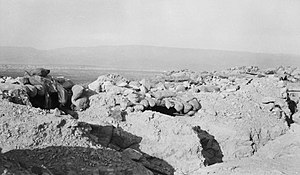| Battle of Abu Tellul | |||||||
|---|---|---|---|---|---|---|---|
| Part of the Middle Eastern theatre of World War I | |||||||
 Turkish defences at Abu Tellul | |||||||
| |||||||
| Belligerents | |||||||
|
| |||||||
| Commanders and leaders | |||||||
|
| |||||||
| Strength | |||||||
|
15th (Imperial Service) Cavalry Brigade 1st Light Horse Brigade[1] B Battery, Honourable Artillery Company[2] | Ottoman 24th Division (supported by two German battalions)[3] | ||||||
| Casualties and losses | |||||||
| 189 including 23 killed, 46 wounded Australian Light Horsemen[4][5] | about 1,000; 105 killed, 45 wounded, 425–540 captured[4][5] | ||||||
The Battle of Abu Tellul (called the Affair of Abu Tellul by the British Battles Nomenclature Committee[6]) was fought on 14 July 1918 during the Sinai and Palestine Campaign of World War I after German and Ottoman Empire forces attacked the British Empire garrison in the Jordan Valley. The valley had been occupied by the Egyptian Expeditionary Force (EEF) from February 1918 when Jericho was captured. Following two raids east of the River Jordan by the EEF the first in March and second in April the defence of the valley became the responsibility of the Desert Mounted Corps.
A German and Ottoman force attacked the Australian Light Horse units defending the heights at Mussallabeh and Abu Tellul on the edge of the Judean Hills, while a German force attacked those defending the Wadi Mellaha midway between Abu Tellul and the Jordan River. As these attacks were taking place on the western bank of the river, on the eastern side the Ottoman Caucasus Cavalry Brigade deployed two regiments, to attack the bridgeheads at the fords of El Hinu and Makhadet Hijla. However, the Ottoman formation was overwhelmed by a combined force of British and Indian troops before it could launch its attack. These were the last attacks against the British forces in this campaign.